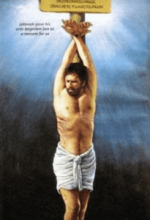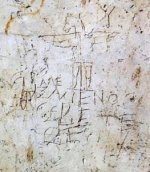You do not have permission to view the full content of this post.
Log in or register now.You do not have permission to view the full content of this post.
Log in or register now.
☰
 You do not have permission to view the full content of this post.
Log in or register now. You do not have permission to view the full content of this post.
Log in or register now.
You do not have permission to view the full content of this post.
Log in or register now.
You do not have permission to view the full content of this post.
Log in or register now. You do not have permission to view the full content of this post.
Log in or register now.
You do not have permission to view the full content of this post.
Log in or register now.
Cross or Torture Stake?
You do not have permission to view the full content of this post.
Log in or register now.10/1/1991
Share
Listen to the audio version of this content
Jehovah’s Witnesses say Jesus wasn’t crucified–executed, yes, but not
crucified, because that word implies he was nailed to a cross.
He was put to death on a torture stake, they say, not on a cross (and surely not on the cross revered by Catholics).
The Watchtower asserts that “In classical Greek the word
stauros, rendered ‘torture stake’ in the New World Translation [produced by the Watchtower], primarily denotes an upright stake or pole, and there is no evidence that the writers of the Christian Greek Scriptures used it to designate a stake with a crossbeam.
There is not a single sentence, in any of the numerous writings forming the New Testament, which in the original Greek bears even indirect evidence to the effect that the
stauros used in the case of Jesus was other than an ordinary
stauros, much less to the effect that it consisted not of one piece of timber, but of two pieces nailed together in the form of a cross.”
Jehovah’s Witnesses insist
stauros can mean only stake. They conclude that, since the New Testament says Jesus died on a
stauros, he did not die on a cross but on a single vertical beam, with his hands nailed together directly over his head.
Such is their case. Their implicit point is that only the Watchtower is the correct interpreter of Scripture. The other churches, particularly the Catholic Church, are false interpreters and are false churches idolatrously venerating a false symbol.
The Witnesses say
stauros “primarily denotes an upright stake or pole.” They wish to suggest (and the reader to understand) that it can mean
only that. In fact, the word has a broader sense. It means cross as well as stake. If you pick up a dictionary and look up the word “square,” you find diverse senses of the word; the dictionary does not confine itself to a single Euclidean definition.
(By the way, notice that the Witnesses refer to “classical Greek.” The New Testament was not written in classical Greek, but in Koine Greek, which has a sense of its own, just as American English has a sense of its own, distinct from that of British English–but the difference between the two Greeks is greater.)
We have to keep in mind the audience the Gospels were addressing. Prospective readers were already Christians and were well aware of what type of execution instrument
stauros referred to. There was no need for a detailed, physical description of the cross and a cataloguing of all the elements of a crucifixion.
In the early Church it was the T-shaped cross that was designated by
stauros in Greek and by
crux in Latin. The evidence for this is abundant and can be found in several areas of study–history, archaeology, art, patrology, liturgical tradition, etymology, paleography, and the New Testament itself.
In 1968 one of the greatest archaeological finds occurred. In an ossuary from burial caves at Giv’at ha-Mivtar in Jerusalem were found the remains of a man, aged 24-28, who had been crucified and died near the year A.D. 70. Though thousands upon thousands had been crucified in antiquity, this was the first time that archaeologists had discovered actual physical remains of a victim. The bones in the ossuary showed the man’s legs had been broken deliberately after the arms and legs had been nailed to a cross of olivewood. The single nail that had pierced the feet had penetrated the ankle bones and could not be extracted before burial.
The description of this archaeological find is given in “Anthropological Observations on the Skeletal Remains from Giv’at ha-Mivtar,” written by N. Haas of the Department of Anatomy at Hebrew University. His article was published in the
Israel Exploration Journal in 1970. Haas describes the scratch marks the nails made on the arms of the executed man:
“The scratch is an artifact produced on fresh bone by compression, friction, and gliding. This artifact, in our interpretation, is the osteological evidence of the penetration of the nail in the interosseous space between the radius and the ulna. The abrupted proximal edge of this scratch is the evidence of the first direct contact of the nail with the radial bone. The smoothly-shaped, vanishing slope is a secondary testimony, explained as the further result of the slight and gradual increasing movement of friction, rotation and gliding between the radial bone and the nail, towards the end of the crucifixion. . . .
“The whole of our interpretation concerning the position of the body on the cross may be described briefly as follows: The feet were joined almost parallel, both transfixed by the same nail at the heels, with the legs adjacent; the knees were doubled, the right one overlapping the left; the trunk was contorted;
the upper limbs were stretched out, each stabbed by a nail in the forearm.” (The emphasis is my own. It should also be pointed out that the article has photographs of the ossuary and of the bones.)
This is the most cogent evidence one could hope to find on the manner of crucifixion in the first century. Keep in mind that this punishment was delivered under Roman rule and that Christ was condemned by the Roman procurator, Pontius Pilate, and was executed by Roman soldiers on a Roman cross–with presumably Roman techniques.
This ossuary is not the only thing archaeology has to show us. The Palatine crucifix is the oldest depiction of a crucifixion. It was uncovered by archaeologists more than a century ago on the Palatine Hill in Rome. It is second-century graffiti scratched into a wall that was part of the imperial palace complex. It includes a caption–not by a Christian, but by someone taunting and deriding Christians and the crucifixions they underwent. It shows crude stick-figures of a boy reverencing his “God,” who has the head of a jackass and is up on a cross with arms spread wide and with hands nailed to the crossbeam. Here we have a Roman sketch of a Roman crucifixion, and it is in the traditional cross shape.
Outside the Christian context are found numerous references to crucifixion in the literature of antiquity. Martin Hengel provides a synopsis of this literature in
Crucifixion in the Ancient World and the Folly of the Message of the Cross. Included is the poem of Pseudo-Manetho. It mocks condemned criminals who are being crucified: “Punished with limbs outstretched, they see the stake as their fate; they are fastened [and] nailed to it in the most bitter torment, evil food for birds of prey and grim pickings for dogs.” Notice: “limbs outstretched.”
Hengel quotes Lucian, writing in the second century of the Christian era, as he describes the nailing of Prometheus to the rocks. The description uses the technical terms applied to a crucifixion: ” . . . and he will be in full sight of everyone as he hangs there. . . . We must not crucify him low and close to the ground . . . crucify him above the ravine with his hands outstretched.”
In this literature from antiquity we find that the letter “T” (the Greek letter
tau) is looked upon as an unlucky letter or sign, similar to the way the number thirteen is looked upon today as an unlucky number. Lucian elucidates the matter by saying that the letter got its “evil significance” because of the “evil instrument” which had that shape, an instrument which tyrants hung men on.
The passion narratives in the New Testament are simple and direct. They do not dwell on the physical details. The early Church did not dwell on them either. They were details the people of the day were acquainted with all too well. The Gospels, sketchy though they are, show the crucifixion of Christ followed the Roman routine we find recorded elsewhere.
The punishment was reserved for non-citizens, for slaves, for the worst of criminals, and for those who were threats to the order of the state. Victims were put on trial under Roman authorities. When convicted they were beaten and whipped and forced to carry the cross–specifically, a crossbeam. This piece was called in Latin the
patibulum.
The prisoners were driven through the city streets and out to the place of execution. There they found in place a vertical beam, mounted in the ground. The Latin term
stipes designates this beam. The prisoners were stripped, nailed to the crossbeams, and then mounted onto the vertical beams to complete the crucifixion. There were variants in some cases, depending on the capriciousness and sadism of the executioners. The crowning with thorns was such a variant.
Nothing in the New Testament indicates a foregoing of the usual Roman use of
stipes (vertical beam) and
patibulum (crossbeam). The Gospel narratives speak of the soldiers whipping Christ, having him carry the cross, stripping him, nailing him, and ******** for his clothes. There is no mention of Christ or the soldiers digging a hole and placing into it the single (vertical) beam which he was forced to carry. The vertical beam already must have been in place, so it was the crossbeam (
patibulum) that he carried and was nailed to.
The nature of crucifixion could not have escaped the early Church. (Nor did the Church want to escape it: Paul insisted on preaching Christ crucified.) Although pictorial representations of the crucifixion of Jesus did not enter Christian iconography until after the peace of Constantine, allusions to it and abstractions of it are ubiquitous long before.
When the initial letters of Christ’s name (
chi rho or the less frequent
iota chi) are superimposed they form the symbol called the Christogram. It takes little effort to find in the Christogram an abstract representation of a man crucified. The Christogram is found repeatedly in pious graffiti at virtually all early Christian archaeological sites.
Early Christian writers left testimony in their writings to a living rubrical tradition.
Semper et ubique (“always and everywhere”) we find the early Church using the rubric of the sign of the cross.
Tertullian testifies to how widespread and ingrained the habit of making the sign of the cross is. “In all our travels, in our coming in and going out, in putting on our clothes and our shoes, at table, in going to rest, whatever employment occupies us, we mark our forehead with the sign of the cross.”
Hippolytus records in his
Apostolic Tradition the practice which by his time is the norm and encourages its continued use: “Do your best at all times to make the sign of the cross on your forehead worthily. This sign of the Passion is a tried remedy against the devil, provided you make it in the spirit of faith.”
Ephraim continues the advice: “My son, mark all your actions with the sign of the life- giving cross. Do not neglect that sign whether in eating or drinking or going to sleep or in the home or going on a journey. There is no habit to be compared with it. Let it be a protecting wall round all your conduct, and teach it to your children that they may earnestly learn the custom.”
Another rubric can be seen in the art of the catacombs. If you watch the priest at Mass, you can see this rubric still in use. It is the posture of the “orant,” in which the one praying stands with his arms lifted up and out to the sides, like a man crucified.
Although the Greek and Latin languages, and thus our own, are alphabetic, an ideographic element is present. An example could be the letter “o.” The letter takes the shape the mouth makes when it utters the sound represented. In the letter “s” are found the shape and sound of a particular animal, so “s” used in such words as “snake,” “serpent,” and “sinister.” The Latin for the word cross is
cruX. The Greek word is
sTauros. Is there evidence here for what the ancients intended to convey when they took the idea of a cross and committed it to alphabetic form?
The French scholar Jean de Savignac studied the New Testament papyri in the Bodmer Collection. These papyri rank among the oldest extant texts of the New Testament. They include substantial pieces of the Gospels of Luke and John dating from around A.D. 250. In these de Savignac found that when the word
stauros was written it was written in a contracted form. In this contracted form the
au is omitted and the
tau and the
rho are superimposed. Professor Kurt Aland broadened de Savignac’s research to include other collections of papyri and found the same.
What we have is the staurogram; it was used in the earliest texts and was used regularly. The staurogram is an image with a horizontal crossbeam. What the copyists of these early texts were conveying is evident.
A last piece of evidence comes from the New Testament: Examine John 20:25, where doubting Thomas speaks. The Witnesses’ New World Translation gives the verse as follows: “Unless I see in his hands the imprint of the nails, and put my finger into the place of the nails, and put my hand into his side, I will not believe.” Even in their own translation John refers to hands (plural) and nails (plural). The inference is simple.
The Jehovah’s Witnesses’ magazines
Awake! and
Watchtower are decorated with illustrations in nearly comic book style. Whenever they depict the death of Christ, they show him hanging from a single vertical pole with both hands fixed together above his head by one nail. Yet the real shape of the cross has been clear to all for centuries, indeed from the first century.
Why this is not clear to the Witnesses is beyond their ability to explain, unless it is that the institution they consider to be the focus of the Whore of Babylon has, as its best-known symbol, the crucifix.
Related
You do not have permission to view the full content of this post.
Log in or register now.
You do not have permission to view the full content of this post.
Log in or register now.
You do not have permission to view the full content of this post.
Log in or register now.
You do not have permission to view the full content of this post.
Log in or register now.
You do not have permission to view the full content of this post.
Log in or register now.
You do not have permission to view the full content of this post.
Log in or register now.
You do not have permission to view the full content of this post.
Log in or register now.
You do not have permission to view the full content of this post.
Log in or register now.
Enjoying this content? Please support our mission!
You do not have permission to view the full content of this post.
Log in or register now.
You do not have permission to view the full content of this post.
Log in or register now.You do not have permission to view the full content of this post.
Log in or register now.
COMPANY
SITES
PUBLISHING

Copyright © 1996-2021 Catholic Answers
You do not have permission to view the full content of this post.
Log in or register now. |
You do not have permission to view the full content of this post.
Log in or register now. |
You do not have permission to view the full content of this post.
Log in or register now.
By continuing to use this site you agree to our
You do not have permission to view the full content of this post.
Log in or register now. and that you have read our
You do not have permission to view the full content of this post.
Log in or register now..






